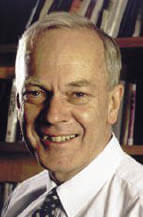Control and Information Architectures for Formations
 Distinguished Professor, Australian National University
Distinguished Professor, Australian National University
Monday October 3, 2011
Andrus Gerontology Center (GER 124) Lecture 3:00 PM
Andrus Gerontology Center Patio Reception 4:00 PM
Hosted by Dr. Sanjit Mitra
Formations of robots, underwater vehicles and autonomous airborne vehicles are progressively being deployed to tackle problems of surveillance, bush fire control, and the like. Much formation behaviour mimics the behaviour of formations of living organisms, such as birds and fish.
Several prototypical problems will be considered, starting with rendezvous and consensus. The presentation will consider the types of control, communications and sensing architecture that allow scalability for formations with many individual agents, and allow preservation of the formation shape, as well as its motion as a cohesive whole. The scalability requirement imposes a need for significant decentralization of information and control structures, and, just as in a formation of birds or fish, no one bird or fish can be expected to sense all other birds or fish and compute its own trajectory using even partial knowledge of the trajectories of all other individual birds or fish, so the amount of sensing, communication and control computation by any one agent has to be limited.
Brian Anderson was born in Sydney, Australia, and received his undergraduate education at the University of Sydney, with majors in pure mathematics and electrical engineering. He subsequently obtained a Ph.D. degree in electrical engineering from Stanford University. Following completion of his education, he worked in industry in Silicon Valley and served as a faculty member in the Department of Electrical Engineering at Stanford. He was Professor of Electrical Engineering at the University of Newcastle, Australia from 1967 until 1981 and is now a Distinguished Professor at the Australian National University and Distinguished Researcher in National ICT Australia Ltd. His interests are in control and signal processing. He is a Fellow of the IEEE, Royal Society London, Australian Academy of Science, Australian Academy of Technological Sciences and Engineering, Honorary Fellow of the Institution of Engineers, Australia, and Foreign Associate of the US National Academy of Engineering. He holds doctorates (honoris causa) from the Université Catholique de Louvain, Belgium, Swiss Federal Institute of Technology, Zürich, Universities of Sydney, Melbourne, New South Wales and Newcastle. He served a term as President of the International Federation of Automatic Control from 1990 to 1993 and as President of the Australian Academy of Science between 1998 and 2002. His awards include the IEEE Control Systems Award of 1997, the IFAC Quazza Medal in 1999, the 2001 IEEE James H Mulligan, Jr. Education Medal, and the Guillemin-Cauer Award, IEEE Circuits and Systems Society in 1992 and 2001, the Bode Prize of the IEEE Control System Society in 1992 and the Senior Prize of the IEEE Transactions on Acoustics, Speech and Signal Processing in 1986.
Published on September 27th, 2016Last updated on August 2nd, 2023

